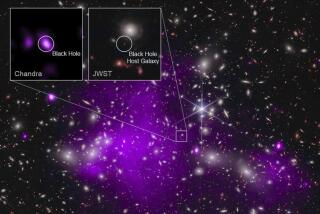Universe Had Long ‘Dark Ages,’ Study Says
- Share via
A multinational team of astronomers said Monday they have peered for the first time into the “dark ages” of the universe--an epoch so ancient that the stars and galaxies now sparkling throughout the night sky had yet to form.
The finding suggests that after the universe formed some 13 billion years ago, it remained a foggy wasteland for 900 million years. Only then did the gas that pervaded the universe after the Big Bang begin to coalesce into stars and galaxies.
“It took a long time--900 million years--for gravity to get its act together and start clumping the gas together,” said Robert Becker, a professor of physics at UC Davis and researcher at Lawrence Livermore National Laboratory who led the team that made the finding. The team includes members of the Sloan Digital Sky Survey, an ambitious project to map a swath of the sky and catalog 200 million celestial objects.
The discovery was made by studying the most distant object known, an energetic quasar detected by the Sloan survey in April that is 14.5 billion light-years from Earth. (Objects that might seem older than the age of the universe--13 billion years--are not. The universe has expanded with time so that older objects are now farther from us than when they formed.)
Members of a rival team based at Caltech announced Monday that they had made a similar finding. They studied a quasar that was not quite as old. Although they were not able to see quite to the dark ages, “we are seeing the Renaissance,” said Daniel Stern, an astrophysicist at the Jet Propulsion Lab who was part of a team led by Caltech astronomer S. George Djorgovski. Both teams will be publishing their results in the Astrophysical Journal Letters.
Because they are as bright as billions of suns, quasars act as a kind of beacon. Astronomers study the light they emit for clues to the conditions of the early universe. In this case, astronomers saw a kind of shadow on the quasar.
They examined the quasar with the Keck, the world’s most powerful optical telescope. When they analyzed the spectrum of light coming from the quasar, they saw that in part of the spectrum, light was absent.
This told them that hydrogen was absorbing the light. Hydrogen absorbs light only when it is neutral and not ionized. The formation of stars and galaxies ionized the hydrogen gas. So that small amount of missing light from the quasar told astronomers that the universe was at least partly neutral when the quasar formed and that “galaxies and stars were not a dominant force,” Becker said.
The quasar hints at what happened during this important shift in the cosmos--when the gas that made up the early universe was changing radically. The quasar, though, only shows the end of the process and not the whole thing. To truly understand why the dark ages ended and the skies began blazing with fiery objects, astronomers will need to study even older objects.
“Hopefully over the next year or two, we’ll find quasars that are more distant so we can pin this down,” Becker said.
The finding confirms a theory developed 35 years ago by two Caltech graduate students, Jim Gunn and Bruce Peterson. Now a professor of physics at Princeton and a driving force in establishing the Sloan survey, Gunn said of the discovery: “Scientists have been looking for this for a very long time. It is tremendously gratifying that we are finally seeing it.”





